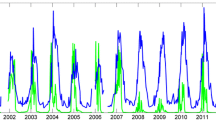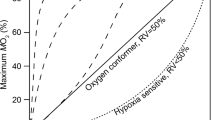Abstract
Gaussia princeps is shown to be a diurnal vertical migrator which spends its days below 400 m in the oxygen minimum layer and migrates to shallower depths (200 to 300 m) at night. This species consumption was measured at 3.5°, 7° and 10°C and 1, 14, 28, 61, 121 and 181 atm of hydrostatic pressure (1 atm corresponds to approximately 10 m of depth). The Q10 of the oxygen consumption is shown to be higher at lower temperatures and higher pressures. Hydrostatic pressure is shown to have significant effects on the oxygen-consumption rate at pressures as low as 28 atm. At all temperature and pressure combinations, G. princeps displays a very low metabolic rate compared to shallow-living copepods. The critical oxygen partial pressure for this species is shown to be about 10 to 13 mm Hg O2 at 10°, 7° and 5.5°C. Based on these data, a predicted relation between depth and oxygen consumption by this species off California, USA, is presented. This shows a higher oxygen-consumption rate at the nighttime depths and a much lower, partially anaerobic metabolism at the daytime depths.
Similar content being viewed by others
Literature Cited
Banse, K.: On the vertical distribution of zooplankton in the sea. In: Progress in oceanography, Volume II. pp 53–125 Ed. by M. Sears. Oxford: Pergamon Press 1964
Barham, E. G.: Deep-sea fishes lethargy and vertical orientation. In: Proceedings of an international symposium on biological sound scattering in the ocean, pp 100–118. Ed. by G.B. Farquhar. Washington, D.C.: Maury Center for Ocean Sciences, Dept. Navy 1971
Belman, B.W. and J.J. Childress: Oxygen consumption of the larvae of the lobster Panulirus interruptus and the crab Cancer productus. Comp. Biochem. Physiol. 44A, 821–828 (1973)
Childress, J.J.: Oxygen minimum layer: vertical distribution and respiration of the mysid Gnathophausia ingens. Science, N.Y. 160, 1242–1243 (1968)
Childress, J.J.: The respiratory physiology of the oxygen minimum layer mysid Gnathophausia ingens, 144 pp. Ph.D. dissertation, Stanford University 1969
—: Respiratory rate and depth of occurrence of midwater animals. Limnol. Oceanogr. 16, 104–106 (1971a)
—: Respiratory adaptations to the oxygen minimum layer in the bathypelagic mysid Gnathophausia ingens. Biol. Bull. mar. biol. Lab., Woods Hole 141, 109–121 (1971b)
—: The respiratory rates of midwater crustaceans as a function of depth of occurrence and relation to the oxygen minimum layer off Southern California. Comp. Biochem. Physiol. 50A, 787–799 (1975)
Clark, L.C.: Monitor and control of blood and tissue oxygen tensions. Trans. Am. Soc. artif. internal Organs 2, 41–48 (1956)
Davies, I.E. and E.G. Barham: The Tucker opening-closing micronekton net ant its performance in a study of the deep scattering layer. Mar. Biol. 2, 127–131 (1969)
Guéredrat, J.A.: Distribution de quatre espèces de copepodes bathypélagiques dans l'oest du Pacifique equatorial et tropical sud. Deep-Sea Res. 16, 361–375 (1969)
Lee, R.F., J. Hirota and A.M. Barnett: Distribution and importance of wax esters in marine copepods and other zooplankton. Deep-Sea Res. 18, 1147–1166 (1971)
Marshall, S.M.: Respiration and feeding in copepods. Adv. mar. Biol. 11, 57–120 (1973)
McLaren, I.A.: Effects of temperature on growth of zooplankton, and the adaptive value of vertical migration. J. Fish. Res. Bd Can. 20, 685–727 (1963)
Meek, R.P. and J.J. Childress: The effect of hydrostatic pressure on the respiratory rate of Anoplogaster cornuta. Deep-Sea Res. 20, 1111–1118 (1973)
Pearcy, W.G. and L.F. Small: Effects of pressure on the respiration of vertically migrating crustaceans. J. Fish. Res. Bd Can. 25, 1311–1316 (1968)
Quetin, L.B. and J.J. Childress: Respiratory adaptations of Pleuroncodes planipes to its environment off Baja California. Mar. Biol. 38, 327–333 (1976)
Schmidt, J.: On the contents of oxygen in the ocean on both sides of Panama. Science, Wash. 61, 592–593 (1925)
Sewell, R.B.S. and L. Fage: Minimum oxygen layer in the ocean. Nature, Lond. 162, 949–951 (1948)
Smith, K.L. and J.M. Teal: Temperature and pressure effects on respiration of thecostomatous pteropods. Deep-Sea Res. 20, 853–858 (1973)
Teal, J.M.: Pressure effects on the respiration of vertically migrating decapod Crustacea. Am. Zool. 11, 571–576 (1971)
— and F.G. Carey: Effects of pressure and temperature on the respiration of euphausiids. Deep-Sea Res. 14, 725–733 (1967)
Author information
Authors and Affiliations
Additional information
Communicated by J.S. Pearse, Santa Cruz
Rights and permissions
About this article
Cite this article
Childress, J.J. Effects of pressure, temperature and oxygen on the oxygen consumption rate of the Midwater copepod Gaussia princeps . Mar. Biol. 39, 19–24 (1977). https://doi.org/10.1007/BF00395588
Accepted:
Published:
Issue Date:
DOI: https://doi.org/10.1007/BF00395588




